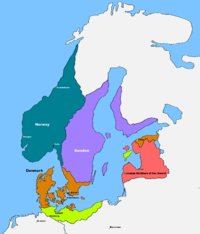Christianization of Pomerania
Earlier attempts at
Bishopric of Havelberg (948-983)
When the Bishopric of Havelberg was founded in 948, the constitution document mentions the area between Peene and Oder among the bishopric's belongings.[1] In 983, the Holy Roman Empire lost control over the region due to a Slavic uprising.[1]
Diocese of Kolobrzeg (Kolberg, 1000 - 1005)
The first Polish duke
During the
Failed mission of Günther (1017)
In 1017, a priest called Günther tried to convert the inhabitants of
Failed mission of Bernard (1122)
Another attempt was made following the subjugation of Pomerania by
Bernard was later made
Otto of Bamberg (1124/28)
After Bernard's failure, Boleslaw III asked Otto of Bamberg[21] to convert Pomerania to Christianity, which he accomplished in his first visit in 1124/25.[22] Otto's strategy differed markedly from the one Bernard used: While Bernard traveled alone and as a poor and unknown priest, Otto, a wealthy and famous man, was accompanied by 20 clergy of his own diocese, numerous servants, 60 warriors supplied to him by Boleslaw, and carried with him numerous supplies and gifts. Otto arrived in Pyritz, and the fact that he was already wealthy assured the Pomeranians that his aim was only to convert them to Christianity, not to become wealthy at the expense of the Pomeranian people. He persuaded the Pomeranians that their conversion would protect them from further punishment by his God, which was how the devastating Polish conquest was depicted. This approach turned out to be successful, and was backed by parts of the Pomeranian nobility who had already been raised as Christians, like Duke Wartislaw I, who encouraged and promoted Otto's mission. Many Pomeranians had already been baptized in Pyritz and also in the other burghs Otto visited.[19][23][24][25][26]
| Date | Event |
|---|---|
| May 1124 | Otto von Bamberg arrives in Pomerania via the Zantoch stronghold.[27]
|
| 5 or 6 June 1124 | first baptism in Pomerania[27] |
| 8 June 1124 | arrival in Pyrzyce[27] |
| 18/19 June 1124 | first baptism in Pyrzyce[27] |
| 24 June - mid-September 1124 | mission in Kamień Pomorski[27] |
| eight days in late September 1124 | mission in and around Wolin[27] |
| nine weeks since early October 1124 | mission in Szczecin[27] |
| mid-December 1124 | mission in |
| late January and early February 1125 | return to Kammin, mission in Cloden, Kołobrzeg and Białogard[27] |
| 11 February 1125 | Otto von Bamberg enters the woodlands between Pomerania and Greater Poland[27] |
| 15 February 1125 or later | Otto arrives in Usch and proceeds towards Gniezno[27] |
Otto of Bamberg returned on 19 April
Adalbert of Pomerania, the later Pomeranian bishop, participated in Otto's mission as an interpreter and assistant.[31]
Pomeranian dioceses
Diocese of Kammin (Cammin, 1140)
On Otto of Bamberg's behalf, a
After ongoing Danish raids, Wollin was destroyed, and the see of the diocese was shifted across the
Dioceses of Włocławek, Roskilde and Schwerin
Pomeranian areas outside the
Wendish Crusade (1147)
In 1147, the Wendish Crusade, a campaign of the Northern Crusades, was mounted by bishops and nobles of the Holy Roman Empire. The crusaders pillaged the land and besieged Demmin and Szczecin despite the fact that both towns were (officially) Christian already. Wollin's bishop Adalbert took part in the negotiations that finally led to the lifting of the Szczecin siege by the crusaders. Ratibor I, Duke of Pomerania, went to the assembly of the Imperial Diet in Havelberg the following year, where he swore to be a Christian.[22][32][33]
Absalon (1168)

After Otto von Bamberg's mission, only the
Monasteries
After the successful conversion of the nobility, monasteries were set up on vast areas granted by local dukes both to further implement Christian faith and to develop the land. The monasteries actively took part in the Ostsiedlung.[25]
|
Dominican OrderCistercian monks
|
See also
- Conversion of Poland
References
- ^ ISBN 3-7338-0195-4.
- OCLC 43087092
- OCLC 43087092
- OCLC 43087092: "Zweifellos waren die Wolliner eine lokale Macht, die zuerst im Veletenbund und später im Liutizenbund eine bedeutende Rolle spielten. Obwohl sie 967 im Kampf gegen Mieszko unterlagen, gelang es den polnischen Herrschern sicherlich nicht, Wollin und die Odermündung zu unterwerfen. Dies läßt sich mittelbar dadurch nachweisen, daß das im Jahr 1000 auf Initiative Otto III. und Boleslaw des Tapferen gegründete Bistum Pommern, das Gnesen unterstand, nicht [pagebreak] in Wollin, sondern weiter östlich in Kolberg seinenSitz hatte. Kolberg gehörte spätestens seit den 60er Jahren des 10. Jahrhunderts zu Polen [...] Anscheinend kam den Wollinern auch eine bedeutende Rolle bei der heidnischen Reaktion in Pommern zu, was vermutlich schon 1005 zur Vertreibung Bischof Reinberns aus seinem [...] [pagebreak] [...] Bistum führte. Die Wolliner waren einer der liutizischen Stämme, die am stärksten auf die Fortsetzung der deutsch-polnischen Kriege in den Jahren 1002 bis 1018 drangen. Sie befürchteten, daß jede Unterbrechungen der Kämpfe Boleslaw auf die Idee bringen könne, den alten polnischen Besitzstand an der Ostsee wiederherzustellen. Sie erreichten ihr Ziel. Alles deutet darauf hin, daß Polen seine Herrschaft über Pommern für mehr als hundert Jahre verlor."
- OCLC 43087092:pagan reaction of 1005
- ISBN 3-88680-272-8: pagan uprising that also ended the Polish suzerainty in 1005
- ISBN 3-412-04577-2, 1005/13
- ^ Oskar Eggert, Geschichte Pommerns, Pommerscher Buchversand, 1974: 1005-1009
- ISBN 3-412-27805-X, 1005/13
- ISBN 0-521-07459-2: abandoned 1004 - 1005 in face of violent opposition
- ISBN 978-0-521-87616-2
- ISBN 978-0-7190-4926-2
- ISBN 978-3-05-003749-3
- ISBN 978-3-515-07498-8
- OCLC 43087092
- ISBN 3-7338-0195-4.
- ISBN 978-83-11-10737-3.
- ISBN 978-0-8369-2803-7
- ^ ISBN 3-88680-272-8
- OCLC 43087092
- ISBN 1-4191-5673-X
- ^ ISBN 3-11-015435-8
- ISBN 978-0-7661-7567-9
- ^ ISBN 1-4179-8323-X
- ^ a b c d Joachim Herrmann, Die Slawen in Deutschland, Akademie-Verlag Berlin, 1985, pp.402ff
- OCLC 43087092
- ^ ISBN 3-7338-0195-4.
- ^ ISBN 3-7338-0195-4.
- ISBN 3-88680-272-8
- ISBN 3-88680-272-8
- ^ ISBN 3-88680-272-8
- ISBN 3-88680-272-8
- ^ Joachim Herrmann, Die Slawen in Deutschland, Akademie-Verlag Berlin, 1985, pp.388ff
- ISBN 3-88680-272-8
- ^ ISBN 3-88680-272-8
